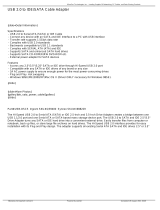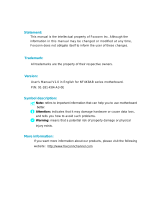
33
33
3
ContentsContents
ContentsContents
Contents
1.1.
1.1.
1.
IntroductionIntroduction
IntroductionIntroduction
Introduction
........................................................................................................................
........................................................................................................................
............................................................
5 5
5 5
5
1.1 Package Contents..................................................................... 5
1.2 Specifications ........................................................................... 6
1.3 Motherboard Layout ................................................................. 8
1.4 ASRock 8CH I/O........................................................................ 9
2.2.
2.2.
2.
InstallationInstallation
InstallationInstallation
Installation
............................................................................................................................
............................................................................................................................
..............................................................
10 10
10 10
10
Pre-installation Precautions ............................................................... 10
2.1 CPU Installation ......................................................................... 11
2.2 Installation of CPU Fan and Heatsink ....................................... 11
2.3 Installation of Memory Modules (DIMM).................................... 12
2.4 Expansion Slots (Future CPU Port, PCI and AGP Slots) .................. 13
2.5 Jumpers Setup.......................................................................... 15
2.6 Onboard Headers and Connectors.......................................... 16
2.7 Serial ATA (SATA) Hard Disks Installation ................................ 19
2.8 Realtek Audio Driver Installation For Windows ME .................. 19
2.9 Installing Windows 2000 / XP / XP 64-bit With RAID Functions. 20
2.10 Installing Windows 2000 / XP / XP 64-bit Without RAID
Functions ................................................................................. 21
2.11 Installing Windows 98 SE / ME on SATA HDD........................... 21
3.3.
3.3.
3.
BIOS SBIOS S
BIOS SBIOS S
BIOS S
ETUP UTILITYETUP UTILITY
ETUP UTILITYETUP UTILITY
ETUP UTILITY
......................................................................................................
......................................................................................................
...................................................
22 22
22 22
22
3.1 Introduction ............................................................................... 22
3.1.1 BIOS Menu Bar ............................................................... 22
3.1.2 Navigation Keys ............................................................. 23
3.2 Main Screen.............................................................................. 23
3.3 Advanced Screen .................................................................... 25
3.3.1 CPU Configuration .......................................................... 26
3.3.2 Chipset Configuration..................................................... 28
3.3.3 ACPI Configuration ......................................................... 29
3.3.4 IDE Configuration ............................................................ 30
3.3.5 PCIPnP Configuration ...................................................... 32
3.3.6 Floppy Configuration ...................................................... 33
3.3.7 Super IO Configuration................................................... 33
3.3.8 USB Configuration.......................................................... 35
3.4 Hardware Health Event Monitoring Screen ............................. 35
3.5 Boot Screen.............................................................................. 36
3.5.1 Boot Settings Configuration ........................................... 36
3.6 Security Screen........................................................................ 37
3.7 Exit Screen ............................................................................... 38





















